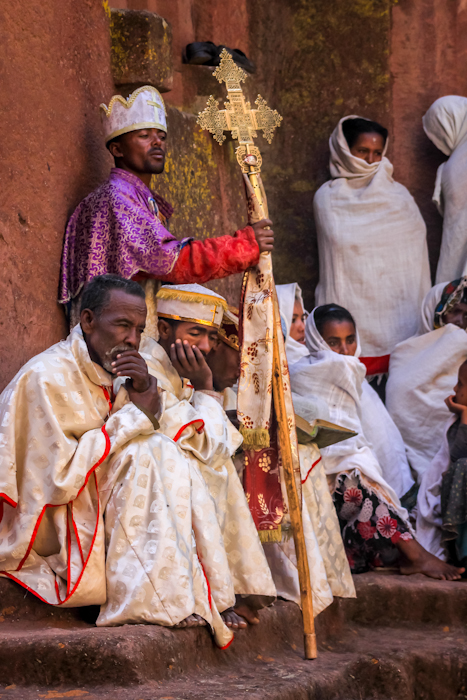Exploring Ancient Orthodox Traditions
WORSHIPER studies holy scripture outside of a rock-hewn church in Lalibela
Followers of the Ethiopian Orthodox tradition overlook a ceremony at St. George Church in Lalibela the week before Easter
DEACONS perform traditional music in front of the Beta Emmanuel Church in Lalibela the week before Easter
A DEACON studies scripture before a reading to hundreds of worshipers at the St. George church in Lalibela the week before Easter
It’s 3:00 a.m. I’m in a church built entirely of stone. One single electric bulb illuminates the entire room. With me there are over a hundred worshipers who have been fasting for the last 72 hours, some without water. They are here to celebrate the rebirth of Christ. I’ve been following the devotees around the rock-hewn churches here in Ethiopia for two weeks getting ready for this moment.
Here on the rugged highland plateau that occupies Eastern Africa, according to the Ethiopian Orthodox Christian Church, an ancient tradition of celebrating Easter lives on. The annual observance of the death and resurrection of Jesus Christ is known locally as “Fasika.”
Each year in mid-April, the Fasika celebration takes place one week later than the western calendar. In the town of Gonder, local Natural Resources Manager Andrew Sisay toldme: “We believe this to be the exact time and date of the rising of Jesus.” Additionally, Sisay adds “To the locals here, the holiday is more important than Christmas.”
Gonder sits over amile and a half above sea level near the border of Sudan and contains a predominantly Orthodox community. I’ve spent the last few days and scoutingand interviewingthe local people. Recommendations from many sources have pointed me to a church on the edge of town where pilgrims from all across the northwest ofEthiopia join the local community to celebrate.
DEACONS read scripture before hundreds of worshipers at the St. George church in Lalibela the week before Easter.
GROUND LEVEL at St. George church in Lalibela. This entire building was originally carved out of the bedrock. The building is, in other words, one solid rock.
Built from rock in the 17th century on top of a hill stands the Debre Birhan Selassie Church. Once vulnerable to attacks from nearby Sudanese tribes, the church has twelve guard towers to protect the edifice from the invaders. These towers were built also to represent the twelve apostles.
Inside the church, the ceiling is painted with intricate renderings of angels and Jesus. During my scouting mission, a hotel manager named Filimon Getachew told me: “The impressive artwork makes this most important church in Gonder.”
EXHAUSTED worshipers doze off during the final hours of the sermon
DEACONS tour the holy scripture for devotees to kiss, demarcating the end of fasting and the beginning of the Easter celebration
I’ve been in the church observing since midnight. Some of the worshippers are nodding off to sleep. Over the distorted speakers a Deacon delivers a passionate sermon. Additionally, the message is broadcast across town with loudspeakers.
At around 3:00 a.m. the sermon ends and the Deacons begin touring the holy text and bring holy water for all to drink. For some, this is the first water they have drunk in 24 hours. The strict interpretation of tradition encourages a no-food-or-water-fast beginning on Good Friday.
WEARY WORSHIPERS guide their way home with beeswax candles from Debre Birhan Selassie Church in Gonder on the night of “Fasika”
After drinking the water, the worshipers ignite beeswax candles to guide them through the dark back to their homes. Back at home, the fast is broken and the families celebrate by killing a chicken. After sleeping in, Easter Sunday feasting beings with cooking and eating fresh sheep meat. “The end of Fasika comes as a big relief to the local community, as we have been eating no meat, egg, milk or chicken for 55 days,” said local pharmacology student Mesafint Alefe over a big bowl of fresh sheep meat for breakfast on April 15. “For the next seven days we will eat lots of meat,” continued Alefe.
I’ve now noticed that since the fast is now over, most of the menus in Ethiopia have lost the vegan options. A slight disappointing to me, as I was enjoying the meat-free lifestyle. This is my last week in Africa. This is also the conclusion of my second trip around the world. I feel lucky to have ended this long journey with observing this spectacular culmination of culture, religion and tradition.
~ David Katz, April 2012 ~
















